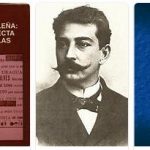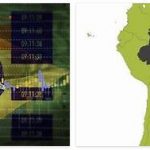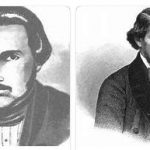Periodic press. – The first Brazilian journalist can be considered Hippolito José da Costa Pereira Furtado de Mendonça (1774-1823), who, persecuted in Portugal, took refuge in London, where he published the Correio Brasiliense, monthly from 1808 to 1822, ceased when, with the proclamation of the independence of Brazil, ended his mission. The first periodical printed in Brazil was the Gazeta do Rio de Janeiro, born three months later than the Correio. Today all states have a thriving periodical press.
Amazonas. – The first periodical, founded by Manoel Silva Ramos, on May 3, 1851, was Cinco de Setembro (September 5, 1850, date of the separation of Amazonas from Pará); then changed the title to Estrella do Amazonas, O Amazonas, Diario do Amazonas, and finally, again, O Amazonas.
Altogether 370 periodicals saw the light of day in this state. Thirteen newspapers and magazines are alive, including 6 dailies, all of which are published in Manáos. The Jornal do Commercio is 24 years old.
Pará. – In March 1822, in Belém, O Paraense was published, weekly and biweekly; chief editor Philippe Alberto Patroni Martins Maciel Parente. He first supported the union of the province with Portugal, under the new constitutional regime of 24 August 1820, then, after the arrest of the Patroni and various events, the adhesion to the government of Don Pedro I. The Luso Paraense el ‘ Astro de Lusitania, Independente from 1823, Amigo da Verdade from 1825, Verdadeiro Independentefrom 1827 and Voz do Amazonas ; from 1876 A provincia do Pará, which was later called O Estado do Pará. There Folha do Norte is 31 years old, the Jornal do Commercio was founded in 1901. In this state, around 740 newspapers and magazines were published, and there are 30 periodicals, including 8 newspapers.
Maranhão. – On November 10, 1821, in S. Luis do Maranhão, the Conciliador do Maranhão was started ; the first scientific periodical was the Folha medicinal (March 1822). Odorico Mendes in 1825 began to draw up the Argos da Lei, João Francisco Lisboa in 1832 founded the Brasileiro and the Pharol Maranhense, in 1834 the Echo do Norte, in 1838 the Chronica Maranhense and in 1852 the literary magazine Jornal de Timon. The total number of periodicals published rises to about 350; there are 20 newspapers and magazines, of which 5 are dailies.
Piauhy. – The Correio da Assembléa Legislativa do Piauhy was published in Oeiras in 1835 ; in 1853, in Therezina, former capital of the province, A Ordem, compiled by José Martins Pereira de Alencastro. David Moreira Caldas founded the Amigo do Povo (1868-72), distributed free to poor readers, and in 1873 the republican Oitenta and nine. There are a total of 209 newspapers published; the most important newspaper is O Piauhy, which succeeded A Democrazia, Fiat Lux and A Epoca.
Ceará. – The Diario do Government do Ceará came out in Fortaleza on 1 April 1824, compiled by Gonçalves Ignacio de Loyola Albuquerque Mello Mororó; the Gazeta do Ceará already existed, handwritten, compiled by Governor Manoel Ignacio de Sampaio. The number of newspapers published in this state reaches a total of 1100; there are 57 newspapers (6 newspapers) and 17 magazines.
Rio Grande do Norte. – In 1832, on the initiative of his father Francisco de Britto Guerra, the Natalense was published, printed outside the province during the first year and then in Natal. In 1833 the Tesoura came out, in 1834 the Publicador Natalense, in 1867, in Assú, the Assuense and in 1889, in Natal, the Republica, the oldest periodical of the state, which had 285 periodicals and has 26, of which 5 newspapers.
Parahyba. – The Gazeta do Government from Parahyba do Norte was founded on February 16, 1826; the Republican Gazeta Parahybana, directed by Antonio Borges da Fonseca, was born in 1828 and was the first republican newspaper in Brazil. Up to now 220 periodicals have been published; there are 18, of which 6 are newspapers. The União dates from 1896.
Pernambuco. – The Aurora Pernambucana, compiled by Rodrigo da Fonseca Magalhães, appeared in Recife on May 27, 1821. The revolutionary movement of the Confederation of the Equator had its organ in Typhis Pernambucano (1823-24), of which 29 numbers came out, compiled exclusively by fra Joaquin do Amor Divino Caneca, one of the victims of the revolution. On November 7, 1825, the first newspaper, the Diario de Pernambuco, was published, directed by Antonino José de Miranda Falcão, who also published, from 1831 to 1834, the Federalist and, in 1832, a humorous newspaper, Simplicio Pernambucano. To the Diario de Pernambuco, among others, Nabuco de Arauio, Tobias Barreto, Fagundes Varella and Silvio Romero collaborated. The illustrious America (1871), the Diabo a quatro (1875), the Lanterna mogica (1882) belong to the humorous press. The periodicals published since 1821 are 2300; there are 54 of them (14 newspapers).
Alagôas. – The first newspaper, published in Maceió, was the Iris Alagoense, biweekly (1831), the second the Federalist Alagoense (1832) and the third, daily, the Diario de Alagôas (1858-1892). The periodicals published so far are 510; there are 15, of which 5 are newspapers.
Sergipe. – The Recopilador Sergipense was released in Estancia in 1832 ; in 1870 the Jornal de Aracajú, first weekly, then daily; in all, 252 periodicals. There are 16, of which 4 are newspapers.
Bahia. – In 1811, A idade de ouro do Brasil came out, an unofficial comic, protected by the Count of Arcos and directed by his father Ignacio de Macedo. The Constitucional (1821), compiled by Francisco Gomes Brandão Montezuma, was followed by many others, who were largely responsible for the republican revolution of 1837. Once this was suffocated, there was again a reactionary press loyal to the government; later still, the newspapers of the two parties, liberal and conservative. The main organ of the first, from 1856, was the Diario da Bahia, which still lives; of the second, the Jornal, by Francisco José da Rocha, which lasted 20 years. Then came the Jornal de Noticias, which lasted 52 years. In all, there were more than 2000 periodicals; there are 92, of which 13 are newspapers. The most important of today’s are A Tarde, the Diario de noticias, the Diario da Bahia and the Imparcial.
Espirito Santo. – Correio de Victoria (1848), one of the first newspapers, was followed by many others, making 260 periodicals in all. There are 31, of which 4 are newspapers.
Rio state. – In 1829 the Echo came out in Nictheroy, dealing with politics and science; in 1832, in the same city, O Tempo and the Caramurú. Among those that are now published, the oldest newspaper is the Fluminense, begun in 1878. Campos had, especially under the second empire, important newspapers, manuscripts, the first, such as Espelho Campista (1825). The Gazeta do povo, from 1886, still lives today. Rezende was one of the first cities of the interior to have periodical printing, with O Genio Brasileiro (1831), the Echo constitucional (1836), the Astro Rezendense (1865), etc. Throughout the state, since 1829, there have been more than 1700 periodicals; there are 91, of which about 12 are newspapers.
Federal capital. – The oldest newspaper printed in Rio de Janeiro was the Gazeta do Rio de Janeiro (10 September 1808), initially biweekly and compiled by fra Tiburcio José da Rocha, which was replaced in January 1823 by the Government Diary. We also mention: the Patriot (1813), literary, political and mercantile; the Conciliador do Reino Unido (1821), founded by José da Silva Lisboa, later Viscount of Cairú; the Diario do Rio de Janeiro (1821), founded and compiled by Zefirino Victor Meirelles. In 1822, with the struggles for independence, Brazilian journalism strengthened; we only remember, among the many newspapers of the time, the Correio do Rio de Janeiro, the first frankly republican newspaper in Brazil, compiled by João Soares Lisboa who was shot in Pernambueo, and the Aurora fluminense (1827), by Evaristo da Veiga, the most famous of the Brazilian journalists. In 1889 68 periodicals were published in Rio de Janeiro; in 1921 there were 13 morning newspapers (Jornal do Commercio, Correio da Manhã, O Paiz, Jornal do Brasil, O Imparcial, O Dia, Gazeta de Noticias, Gazeta dos Tribunaes, Gazeta suburbana, A Patria, A Razão, O Social, A União) as well as 5 Italians and one French; 9 evening newspapers (A Noticia, Jornal do Commercio, A Tribuna, A Noite, A Rua, Boa Noite, O Combate, O Rebate and O Rio – Jornal), as well as about fifty other periodical publications, including the Revista da Academia Brasileira de Letras and the Revista do Instituto Historico e Geographico Brasileiro. For Brazil 2015, please check dentistrymyth.com.
S. Paul. – The first newspaper was Pharol Paulistano (1827); the second newspaper, O observador constitucional (1829). But the periodical printing soon flourished: in 1840 there were just 6 newspapers; which rose to 283 magazines, of which 58 in the capital. The oldest is the Correio paulistano (1854); we still remember the ‘ Estado de S. Paulo, the Jornal do Commercio, Diario popular, A Platéa, Saõ Paulo Jornal, A Gazeta, Germany, Commercio de Campinas ; also three Italian newspapers, one French, one German, one Spanish.
Paraná. – The Dezenove de Dezembro (Curityba 1848), was one of the first of about 400 published periodicals. German and Polish emigrants soon had their organs. There are 47 periodicals including 12 newspapers, some in German, Polish and Ruthenian.
Santa Catharina. – In 1831 in Desterro, today Florianopolis, O Catharinense appeared. The total of periodicals is 200; about 42 are published, of which 6 are newspapers; among them, two are in German.
Rio Grande do Sul. – The Diario de Porto Alegre and the Constitucional Riograndense came out in 1827; in 1854 the Echo do Sul, which still exists today. Notable and numerous, among the approximately 2000 periodicals (231 of which 30 are newspapers), those in foreign languages.
Minas Geraes. – In Ouro Preto, then the capital of the province, the first newspaper, the Compilador Mineiro, appeared three times a week on 13 October 1823, followed by the Abelha do Itaculumy three months later. The oldest extant newspaper is the Pharol which is 43 years old. In all, the periodicals rise to about 2000 (255 are published, of which 13 are newspapers).
Matto Grosso. – The Gazeta Cuyabana, dated 1847, was followed by other periodicals, 150 in all; there are 40, of which 3 are newspapers.
Goyaz. – La Matutina Meyapontense, came out in Meya in 1830. The Correio Official, from 1844, lived more than 50 years. There were 120 periodicals in all (there are 12, none daily).
Acre. – The first Portuguese newspaper published in this area was Acre (Catapará, 2 May 1904). There are 6 weekly.









